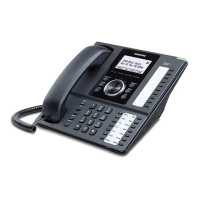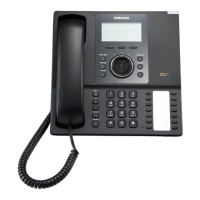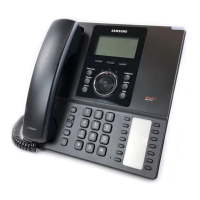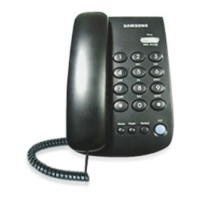Do you have a question about the Samsung SMT-I3105 and is the answer not in the manual?
Read installation instructions, handle power plugs carefully, avoid dust, heat, and flammable materials.
Verify all included components are present in the product package box.
Guide to connecting the phone body, handset, and LAN cable for installation.
Diagram and labeling of the SMT-i3105 keyset components and buttons.
Detailed explanation of each button and its corresponding function on the keyset.
Overview of network, LCD screen, and SMS capabilities of the SMT-i3105.
Explanation of the LED indicator patterns and their meanings for phone status.
Description of the three main areas of the phone's LCD screen.
Guide to entering characters, numbers, and special characters using the keypad.
Explanation of the meaning of various icons displayed on the phone screen.
How to use dial pad keys and navigation buttons for menu options.
Steps to initially set up the IP keyset for network operation.
Procedure to access the setup menu by unplugging and plugging the power cord.
Guide to using the wizard for setting up network parameters automatically.
Instructions for manually entering IP address, subnet mask, and gateway details.
How to configure the keyset for logging in and out without rebooting.
Guides through setup of parameters for connecting the keyset to the system.
Provides version, network, and MAC address information for the phone.
Displays IP settings, PPPoE, NAT, VLAN, and options to use or not use.
Allows login/logout from idle mode or registration on power up.
Setting the IP address for the primary system and up to four servers.
Details on configuring TFTP server and initiating the IP software upgrade.
Resets the SMT-i3105 to its original factory default settings.
Option to reboot the SMT-i3105 phone.
Procedure to log in with extension and password, or log out.
Instructions for making outside and internal calls, including overlap mode.
How to answer incoming outside, internal, and voice announce calls.
Steps for system hold and exclusive hold to place calls on hold.
Procedure for transferring calls with or without notification.
How to camp a call on to a busy station.
Procedure when an outside call is camped-on to your phone.
Steps to initiate and manage conference calls with multiple parties.
How to program call forwarding destinations via keypad or display.
Adjusting volume for handset, speaker, and ringing tone.
Accessing call history, scrolling menus, and deleting calls.
Accessing stored contacts and scrolling through menus.
Used to enter, save, or complete selected options in the display.
Used to activate or deactivate the hands-free speakerphone mode.
Displays options like Phonebook, Call Log, Message, Sound, Security, Call Fwd, Settings.
How to access and navigate the basic menus displayed on the screen.
Explains the layout and function of the soft buttons on the display.
Lists and describes options available via the Menu soft button (PhoneBook, Call Log, Message).
How to view all lists, search numbers, add entries, and delete all entries.
Lists recent outgoing, incoming, and missed calls; allows deletion of call history.
Instructions for accessing voice mail, station messages, and e-mail messages.
How to view detailed Caller ID information for each call log entry.
Procedure for creating and sending internal short text messages (SMS).
How to edit and resend messages from the outbox.
Procedure to delete all short messages from both inbox and outbox.
Adjusting volume levels for ringtone, handset, speaker, and key tone.
Setting station password, locking or unlocking the phone.
How to set or cancel call forwarding to different destinations.
Setting dial mode, language, network info, AOM, and clearing user data.
Setting dial mode to Enbloc or Overlap for dialing numbers.
Selecting the display language for the phone.
One-touch access to system features like Redial, Speed Dial, Directory, etc.
Displays all 99 programmable feature buttons for one-touch operation.
How to make calls using programmable button screens accessed via AOM.
How to answer calls ringing a general alerting device.
Procedure to disconnect a call and get dial tone for a new call.
How to send a flash signal to the telephone company.
Procedure for receiving a callback when a line is busy.
How to receive a callback when a called station is busy.
Procedure to cancel a set callback.
How to camp on to a busy station without waiting.
How to use voice announce mode to hear caller announcements.
How the keyset automatically answers incoming calls.
Procedure to dial 0 to reach the system operator or specific operators.
How to place a call on system hold and resume it.
How to place an outside call on hold so other users cannot access it.
How to place a call on hold at another station.
Notification when a held call recalls your station.
How to consult with another extension during a call.
How to pick up calls held at another station.
Methods for screened and blind call transfers.
How to send a call directly to a voice mailbox.
Procedure when an outside call is camped-on to your phone.
How to review or change call forward options and destinations.
How to pick up a call ringing at another station.
How to pick up calls ringing in a pickup group.
Assigning a new access code to pickup calls in the same pickup group.
Allows another station to join a conversation by releasing privacy.
How to dial preprogrammed system-wide or personal speed dial numbers.
Steps to program frequently dialed numbers into the personal speed dial list.
How to access and dial numbers from station, personal, or system directories.
How to redial the last outgoing telephone number dialed.
Saving a dialed number for later use and redialing.
How the system automatically redials a busy number up to 15 times.
How to send digits as tones on a pulse dial line.
Procedure to make an announcement through keyset speakers.
Procedure to make an announcement through external paging speakers.
How to page all designated keysets in internal and external zones simultaneously.
How to initiate a Meet Me Page and have parties dial a specific number.
Methods for manually parking calls and paging for retrieval.
How to leave a message indication at another station.
Procedure to cancel message indications left at your station or at others.
How to return station messages and manage message indications.
How to leave programmed station messages for status updates.
Procedure to log in to the phone system with extension and password.
How to block incoming calls and cancel DND mode.
How to temporarily enable DND during a call, which cancels automatically.
How to mute or unmute the handset transmitter or microphone.
How to listen to music through the speaker, and adjust volume.
How to pick up an established call connected to a computer modem.
Procedure for receiving and answering calls from a door phone.
How to call a door phone or room monitor and listen or converse.
How to enable speaker output for others to hear during a call.
How to enter account codes before or during a call for charging purposes.
How to send a brief ring burst to another station.
How to make an off-hook voice announcement to another station.
How to prevent others from making OHVA calls to you.
How to disconnect an OHVA party and return to original call.
How to remove or add your keyset to a station ring group.
Enabling password protection for AME feature to prevent unauthorized access.
How to automatically camp on to busy stations for intercom calls.
How users can select their preferred ring tone from available options.
Procedure to change the station's default passcode.
Setting intercom call reception to Ringing, Auto Answer, or Voice Announce.
Setting incoming CO calls to follow the intercom answer mode.
Turning the automatic hold feature on or off for call handling.
Enabling the keypad to be 'live' for dialing without lifting handset.
Turning the short beep (confirmation tone) for button presses on or off.
Enabling feature to hear remaining portion of an ongoing internal page.
How to set automatic answering of calls or manual answering.
Viewing the name associated with a speed dial number as it is dialed.
Reviewing Caller ID information for incoming calls.
Receiving OHVA calls via speaker while on handset.
Configuring options for Mobile Extension ports, including phone numbers.
How extension and line names are assigned and displayed.
How dialed digits are shown on the display until the call timer starts.
How the system times outside calls, automatically or manually.
How the timer automatically starts for incoming or outgoing calls.
Using the Timer button as a simple stopwatch.
How to view message indications left by other stations.
Assigning an 11-character name to personal speed dial numbers.
How to enter and store station names for directory purposes.
How to manage key assignments for one-touch feature access.
How to delete digits using Backspace or Clear when using LCR.
How to choose what Caller ID information (name/number) is displayed.
How to display Caller ID for queued or camped-on calls.
Viewing Caller ID for calls on hold or parked.
List of dial codes for accessing various phone features and functions.
How to access voicemail from inside or outside the office, and navigate menus.
Detailed breakdown of options available within the voicemail system.
Initial steps for users to set up and use Samsung Voicemail.
How to listen to new and saved messages, and control playback.
Procedure for sending messages to other subscribers.
Configuring delivery options like urgent delivery and return receipts.
Setting future delivery dates and times for messages.
Subscriber control over call reception and handling based on events.
Setting an alternate location for calls and how long it remains active.
Blocking callers from reaching extension, directing them to mailbox.
Passing call control to another subscriber.
Asking caller's name before transferring to accept or reject call.
Locating subscriber by calling a list of preprogrammed phone numbers.
Using weekly availability schedule for night greetings.
Recording and assigning personal greetings for different call conditions.
Greeting played when Call Screening is enabled and a caller is rejected.
How to edit or record any of the nine personal greetings.
Editing the greeting played when callers reach the mailbox directly.
Turning pager notification, message alerts, and other message controls on/off.
Setting up notifications for new messages at a remote location.
Setting up notifications via pager service for new messages.
Recovering recently deleted voice mail messages.
Recalling sent messages that have not yet been picked up by the recipient.
Enabling or disabling automatic playback of new messages.
Enabling automatic playback of message date, time, and sender's name.
Sending messages to all mailboxes in the system.
Accessing reminders, stored numbers, availability schedules, and direct calls.
Accessing and organizing reminders (Commitments, Follow-Ups, Tasks).
Entering up to 9 stored phone numbers for use with other features.
Setting a weekly availability schedule for Night Personal Greeting.
Placing direct calls out of voicemail from anywhere.
Changing password, recording name, and entering directory name.
Procedure to change your voicemail access code.
Recording your name for proper operation of the voicemail system.
Entering your directory name for callers to find you.
Reducing the number of prompts played in the subscriber interface.
Features available on display keysets, requiring administrator setup.
How the message waiting light indicates new voicemail messages.
Using a key to monitor calls to voicemail and optionally answer them.
Entering station password to listen to messages when AME Password is enabled.
Pressing a button to record the current conversation in progress.
Quick methods for sending calls to mailboxes or leaving reminders.
Using soft keys and displays to manage messages and call information.
Integrating voicemail with email clients for message delivery and notification.











